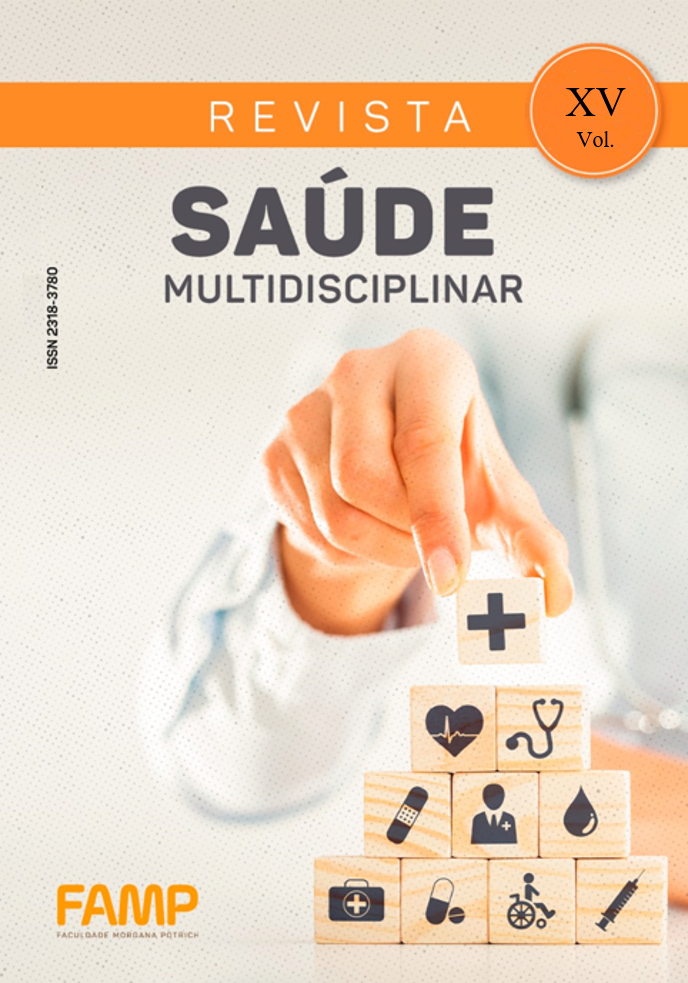TRANSPLANTE DE CÓRNEA EM CERATOCONE: RELATO DE CASO
DOI:
https://doi.org/10.53740/rsm.v15i2.746Keywords:
Relato de caso. Ceratocone. Transplante de córnea. Implante intraocularAbstract
Keratoconus is an uncommon bilateral degenerative disorder, identified by the gradual deformation of the curvature of the cornea, causing a thinning in the shape of a cone, which can be inherited as an autosomal recessive or dominant trait. This study aims to describe a clinical case of keratoconus in which there was surgical intervention for corneal transplantation and discuss the late diagnosis and treatment. Report: Male, 33 years old, diagnosed with keratoconus since he was 19 years old. The initial treatment included the use of soft and rigid lenses, implantation of intrastromal ring segments, implanted in both eyes. Due to the late diagnosis, the disease progressed in the Left Eye (LE), being indicative for corneal transplantation, a procedure successfully performed, but without visual improvement in the LE. Keratoconus evolved in the RE, requiring the Crosslinking surgical technique, stabilizing the disease in the RE. According to the literature, despite the late diagnosis, the only remedial treatment for severe cases is corneal transplantation or keratoplasty, but this report reveals another determining factor for the visual acuity of the EO of the patient in question, which is the need for implant of the IOL for correction of 22 diopters of myopia. In addition, it was possible to demonstrate that, in this case of bilateral keratoconus, the intrastromal ring technique performed in both eyes demonstrated disease paralysis for about 10 years in the RE and without success in the LE
References
MOUSSA, Sara; GRABNER, Gunther; RUCKHOFER, Josef et al. Genetics in keratoconus – What is new? The Open Ophthalmology Journal, v. 11, p. 201-210, 2017.
WHEELER, Joshua; HAUSER, Michael A.; AFSHARI, Natalie A. et al. The Genetics of Keratoconus: A Review. NIH, june 2013.
GOKUL, Akilesh; PATEL, Dipika V. ; MCGHEE, Charles NJ. Dr John Nottingham's 1854 Landmark Treatise on Conical Cornea Considered in the Context of the Current Knowledge of Keratoconus. Cornea. 2016 May;35(5):673-8.
GORDON-SHAAG, Aricla; MILLODOT, Michel; SHNEOR, Einat et al. The genetic and environmental factors for keratoconus. Biomed Res Int, v. 2015, 2015.
GHASSEMBAGLOU, Navid; DJALILIAN, Ali R. Keratoconus; a True Corneal Disease. J Ophthalmic Vis Res, v. 11(1), p.1-2, 2016.
NADERAN, MOHAMMAD; RAJABI, MOHAMMAD TAHER; ZARRINBAKHSH, Parviz, et al. Association between Family History and Keratoconus Severity. Curr Eye Res. 2016;41 (11):1414-1418.
LOPES, Alessandro Garcia. Análise genética e molecular do Ceratocone envolvendo os genes VSX1, SOD1, TIMP3 e LOX. São José do Rio Preto: UNESP, 2018. 133 p. Tese, Programa de Pós-Graduação em Biociências, do Instituto de Biociências, Letras e Ciências Exatas da Universidade Estadual Paulista “Júlio de Mesquita Filho”, Campus de São José do Rio Preto, 2018.
Netto AA, Botelho CAS, Felicíssimo LC. Indicações e perfil epidemiológico dos pacientes submetidos à ceratoplastia. Rev Bras Oftalmol. 2014; 73 (3): 162-6
Cruz, Giovanna Karinny Pereira et al. Clinical and epidemiological aspects of cornea transplant patients of a reference hospital. Revista Latino-Americana de Enfermagem [online]. 2017, v. 25. ISSN 1518-8345. https://doi.org/10.1590/1518-8345.1537.2897.
SCHOR, Paulo. Ceratocone. Arq. Bras. Oftalmol. São Paulo, v. 61, n. 2, p. 235-237, Apr. 1998.
RIORDAN–EVA, Paul & WHITCHER John P. Oftalmologia geral de Vaughan & Asbury. 1ª Ed. McGraw Hill Brasil, 2011.
SALLUM, Juliana M. Ferraz; ERWENNE, Clélia M. Estudo da etiologia genética do ceratocone. Arq. Bras. Oftalmol., São Paulo , v. 61, n. 2, p. 141-147, Apr. 1998.
TARDIN, João Roberto Garcia; BASTOS, Mônica Araújo; BORGES, Kleber Sampaio Fragoso. Resultado biomecânico, topográfico e anatômico pós-anel intraestromal em ceratocone avançado. Rev. bras. oftalmol. Rio de Janeiro , v. 72, n. 4, p. 268-270, Ago. 2013.
Tiverson-Junior MC. Avaliação da córnea e da acuidade visual em indivíduos portadores de ceratocone, antes e após tratamento cirúrgico. São Paulo, 2020. Tese de Doutorado - Faculdade de Medicina de São Paulo – Programa de Oftalmologia, 2020.
Salomão M, Hoffling-Lima AL, Lopes B, Belin MW, Sena N, Dawson DG, et al. Recent developments in keratoconus diagnosis. Expert Rev Ophthalmol. 2018;13(6):329–41.
SIQUEIRA, Marcelo Alves Vilar de et al . Anel corneano intraestromal assimétrico no tratamento do ceratocone. Arq. Bras. Oftalmol. São Paulo , v. 73, n. 5, p. 454-458, Out. 2010.
Sauder G, Jonas JB. Tratamento do ceratocone por lentes intraoculares dobráveis tóricas. Eur J Ophthalmol. 2003; 13 (6): 577-9.
ELIAS, Rosana Molina Saraiva et al . Ceratocone: fatores prognósticos. Arq. Bras. Oftalmol., São Paulo, v. 68, n. 4, p. 491-494, ago. 2005.
Additional Files
Published
How to Cite
Issue
Section
License
Copyright (c) 2023 REVISTA SAÚDE MULTIDISCIPLINAR

This work is licensed under a Creative Commons Attribution-NonCommercial-NoDerivatives 4.0 International License.









